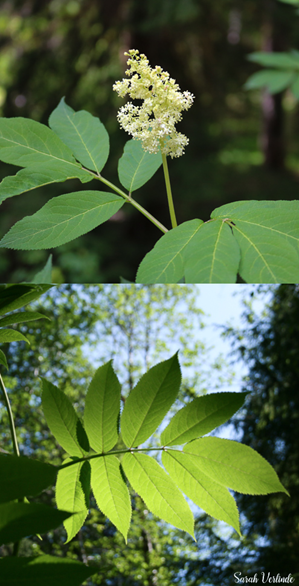Red elderberry
Sambucus racemosa – Red elderberry
Morphology

- Family: Adoxaceae
- Plant Type: deciduous upright/branching shrub
- Height: 7-20 feet tall
- Fragrance: light and floral when flowering with leaves that are foul-scented when crushed
- Leaves: long, oval, and serrated finely around the edges having a darker green surface, and light, paler green color on the underside, the texture becomes crispy and leathery as they mature. Opposite arranged.
Habitat and Distribution
Habitat: Riparian zones where a river or stream is nearby for adequate moisture. Sunny to part-shade.

Commonly known as red elderberry, Sambucus racemosa, is widely dispersed in the United States from Southeast Alaska to New Mexico, with other groupings in California and Arizona where conditions are optimal. In Washington state, the red elderberry grows in riparian zones ranging from around 7-20 feet tall as a large tree-like shrub. Defining features of the red elderberry include its leaflets with long oval serrated edges that can be 16 centimeters long, with layering pyramidal flowers blooming from its stems. When recognizing elderberry, there will be noticeable pale yellow to creamy white flowers in April. Later, in June and July, bright red berries appear with 2-5 seeds per fruit. The flower of red elderberry can smell unpleasant when crushed or have a faint floral scent.
Reproduction
- Reproduction: flowers with pyramidal white (not flat-topped) floral clusters. Berries fruit in early summer and are red.
- Flower color: light, creamy white with a yellow tone
- Flowering Season: April-May
- Generation: Perennial
Ethnobotanical Uses
Red elderberry has been used by various North American tribes for both medicinal purposes and food uses in many meals. While the seeds of the red elderberry are poisonous, if they are removed, the berries can be eaten raw or cooked. In their raw form, these berries (and seeds) were specifically helpful to Native Americans as they were used as an emetic and purgative to detoxify the bodily system in laxative form. While this may be true, the toxicity is greatly reduced when the berries are cooked, and they can be enjoyed in foods such as pies, jellies, or even in wine. Interestingly, the leaves were used to treat boils, and the root could be infused to treat stomach pains or rubbed onto the skin to help with aching or sore muscles. Today red elderberry is used in natural medicine for many purposes, ranging from sinus infections (used in a nasal spray), to lowering blood pressure. Elderberry extract has also been used in cancer remedies because of anti-carcinogenic properties which may inhibit the growth of certain forms of cancer.
Restoration/Conservation
Elderberry is a fairly tall shrub which does well in small patches of sun in riparian and forested areas. Tall tree species of the Pacific Northwest such as the Douglas-fir and western red-cedar can impede its growth by blocking a majority of the sunlight path. The plant will do best near a creek or moist area in the garden. Red elderberry can be used in restoration plantings to help with erosion control and re-vegetative purposes. Unlike many other plants, elderberry is tolerant of heavy metal contaminated soils and grows well around mining and smelting sites where the land has been disturbed. Elderberry is also used for conservation efforts because many other organisms benefit from it. It provides cover for small mammals and birds, allowing hummingbirds to collect its nectar from its flowers in April and May, and the berries are an additional food source for some bears when salmon becomes more difficult to hunt.
Resources:
- “Sambucus racemosa.” WNPS Home, wnps.org/native-plant-directory/8-sambucus-racemosa.
- “Red elderberry, Sambucus racemosa.” California Native Plant Society, calscape.org/Sambucus-racemosa-(Red-Elderberry)?srchcr=sc5ced98bfd9ca4.
- Axe, Josh. “Elderberry: The Immune-Booster That May Combat Allergies & Cancer.” Dr. Axe, 27 Aug. 2018, draxe.com/elderberry/.
- “Medicinal Herbs Red Elder Sambucus racemosa.” Medicinal Herbs: RED ELDER – Sambucus Racemosa, www.naturalmedicinalherbs.net/herbs/s/sambucus-racemosa=red-elder.php.
- “Sambucus racemosa.” Sambucus racemosa, Fire Effects Information System (FEIS), www.fs.fed.us/database/feis/plants/shrub/samrac/all.html
- “Exploring the Use of Red Elderberry (Sambucus racemosa) Fruit on the Southern Northwest Coast of North America.” Journal of Archaeological Science, Academic Press, 25 Feb. 2003, www.sciencedirect.com/science/article/pii/S030544030200242X.
This article was written by Audrey Figgins, 2019, and edited by Sarah Verlinde. For questions regarding the UWB/CC Plant Tour, contact Sarah at severlin@uw.edu.
